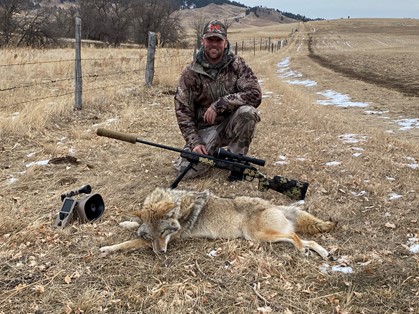Down Time
 By Craig Gillock
By Craig Gillock
If you're anything like me, and your life revolves around hunting, the months of June, July, and August are a painful time of year. Unless I can convince my wife that I NEED to sneak out west on a spring bear hunt or that I absolutely HAVE to travel to Africa or Australia on safari, my hunting seasons are over until the fall. This simply does not work for me.
As I just mentioned, there are opportunities available, but they cut into vacation time (this is where the wife’s permission starts to become a factor) and neither is the most budget friendly activity. So, three years ago, after returning home from a British Columbia black bear hunt, I made a small revision to my hunting calendar. I still go spring bear hunting as often as I can, it’s just too much fun not to, but now I also stay a little closer to home and focus my attention on the predator and varmint populations.
In my home state of Pennsylvania, these populations are comprised primarily of coyotes and woodchucks (ground hogs). There are a few other critters that fall into these categories but, their numbers are not really abundant. With the proper license, these animals can be hunted almost year round and have no bag limit. This makes them ideal prey when all the other seasons are closed.
There are people out there who will read this and accuse me of being cruel and a violent sociopath who just enjoys killing. I honestly don’t care what those people think, but nothing could be further from the truth. Proper management of these species produces several positive results.
Coyotes kill deer. That statement is fact. Coyotes kill domestic pets such as cats and dogs. That statement is also fact. Coyotes kill livestock. Yet again, fact. There are studies that claim coyote predation only affects the old or weak members of a species and that the animals they kill would have most likely died of some other cause. This is referred to as compensatory predation, and it posits that the animal acting as the predator doesn’t add to the death rate, it simply serves as a different cause.
Other studies, however, suggest that coyote predation is additive, meaning that their kills add to the numbers lost due to disease, starvation, or any number of other environmental factors. These studies have proven factual enough that states such as South Carolina, with newly established coyote populations, have tasked their wildlife management agencies with developing new strategies to protect deer herd numbers.
And, if anyone doesn’t believe coyotes kill pets, livestock, and healthy, mature animals, a quick Google search will provide more than enough video and photographic evidence to the contrary. Seeing a video of Fluffy the cat, Fido, or a half-eaten monster buck being carried past a game camera is an eye-opening and grotesque reminder of just how much damage a predator can inflict.
Ground hogs, also known as woodchucks, whistle pigs, or as my dad likes to call them, pithols (no idea where that comes from), present a whole different set of problems.
The problems associated with ground hogs pertain primarily to their digging habits. Ground hog burrows can be very large and pose multiple risks. From an agricultural standpoint they:
- Damage crops when they burrow through and destroy the root system
- Cause damage to farm equipment when the equipment hits their holes and mounds
- Can injure livestock if the livestock stumbles in one of their holes
- Can destroy irrigation systems if they burrow through them
Most farmers will allow or even welcome you to hunt ground hogs on their property.
These are just a few reasons to take up predator/varmint hunting. One reason I haven’t mentioned yet is that it will help improve your shooting skills. If you can pick off a ground hog or a coyote at a couple hundred yards, you will not have any problem making ethical shots on larger game.
This year I have three different calibers set up to use: 6 Creedmoor, 6x47 Lapua, and 6.5-284 Norma. Some people will say these calibers are too big, especially for ground hogs, but I’ve used all the way up to .270 Win to hunt these animals. I chose these three calibers because I feel they have a good combination of speed, power, and low recoil. Not to mention they are calibers that are readily available.
So, stay tuned through out the summer and fall as we post pics, videos, and tips on predator and varmint hunting. Until then, good luck and happy hunting!